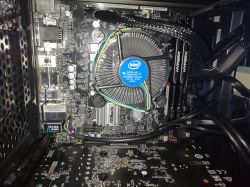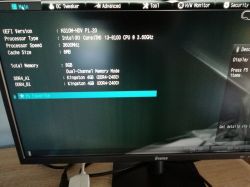FAQ
TL;DR: Fix a PC that "shuts down" but stays on by a 30‑second CMOS reset; "Removing the BIOS battery for approximately 30 seconds" restored normal power‑off. [Elektroda, matyjeste, post #17182014]
Why it matters: Quick, no‑cost steps for Windows 10 builders whose fans, GPU, and CPU keep running after shutdown.
Quick Facts
- A ~30‑second CMOS reset (battery out/in) fixed this H310M‑HDV build’s no‑power‑off behavior. [Elektroda, matyjeste, post #17182014]
- Windows 10 Fast Startup uses hybrid hibernation; disable it to test a full power‑off. [“Shut down, sleep, or hibernate your PC”]
- ATX spec: +5VSB stays on in soft‑off; main rails drop when PS_ON# is asserted. [ATX12V Power Supply Design Guide]
- Clearing CMOS restores UEFI defaults; re‑set boot order, XMP, and wake options afterward. [ASRock H310M-HDV User Manual]
How do I fix a Windows 10 PC that shuts down but stays on?
Reset CMOS to clear a stuck power state. How-To:
- Shut down and unplug the PSU.
- Remove the CR2032 battery for about 30 seconds.
- Reinstall the battery, boot, and load BIOS defaults.
Reconfigure boot order and memory settings. This restored normal power-off in the reported build. [Elektroda, matyjeste, post #17182014]
Which UEFI/BIOS settings can keep components powered after shutdown?
Enable ErP/Deep Sleep for S4/S5 to cut standby power. Disable USB Keyboard/Mouse Power On and PCIe/PCI Device Power On. Also disable Wake on LAN if not needed. Edge case: With Deep Sleep disabled, some USB ports can stay powered in S5. Check these options under Advanced and ACPI menus on H310M-HDV. [ASRock H310M-HDV User Manual]
Can Fast Startup in Windows 10 cause the PC to not fully power off?
Yes. Fast Startup uses a hibernation file and can mask shutdown problems. Disable it to test a true hardware power-off path. Go to Control Panel > Power Options > Choose what the power buttons do. Click Change settings that are currently unavailable and uncheck Turn on fast startup. “Fast startup helps start your PC faster.” [“Shut down, sleep, or hibernate your PC”]
Is removing the BIOS battery safe, and how long should I wait?
It is safe if the system is unplugged first. Wait about 30 seconds, then reinstall the battery. This clears CMOS and resets UEFI to defaults. You will need to reconfigure settings afterward. [Elektroda, matyjeste, post #17182014]
Will clearing CMOS erase my files or Windows installation?
No. Clearing CMOS only resets firmware settings like boot order and memory profiles. Drives and the Windows installation remain unchanged. After clearing, enter UEFI and load defaults, then set boot order. [ASRock H310M-HDV User Manual]
What else should I try if a CMOS reset doesn’t fix it?
Update the motherboard BIOS and device drivers. Then run Windows’ power troubleshooter and retest. Also check device drivers that control power, like chipset and graphics. Microsoft documents these steps for shutdown issues. [Troubleshoot problems shutting down Windows]
Why do my fans keep spinning after shutdown?
In soft-off (S5), only +5VSB should remain active. Fans need the main 12 V rails. Spinning fans mean the PSU rails did not drop. That points to PS_ON# not asserted or ACPI issues. Fix by verifying UEFI power settings and clearing CMOS. [ATX12V Power Supply Design Guide]
How do I perform a one-time full shutdown in Windows 10?
Run a command that bypasses Fast Startup. Open an elevated Command Prompt and run: shutdown /s /t 0. Then check whether the system fully powers off. [shutdown command (Windows)]
Could a weak CMOS battery cause shutdown problems?
A weak CR2032 mainly causes time or settings loss, not spinning fans. Replace it if the clock resets or settings don’t stick. A CR2032 cell is nominally 3.0 V. [Panasonic CR2032 Datasheet]
How can I clear CMOS on an ASRock H310M-HDV without removing the battery?
Use the Clear CMOS jumper. Power off and unplug. Short the CLR_CMOS pins with a cap or screwdriver for several seconds. Reconnect power, boot, and load UEFI defaults. This resets firmware settings like the battery method. [ASRock H310M-HDV User Manual]
What is ACPI S5, and how is it different from sleep?
S5 is soft-off. The system is off except for standby power. Sleep can be S3 or modern S0 low power idle. In sleep, memory stays powered and resume is faster. S5 requires a full boot to resume. [System power states (Windows)]
Does this fix apply to an i3‑8100, H310M‑HDV, GTX 1050 Ti build?
Yes. That exact configuration reported success after a 30‑second CMOS reset. The system then powered off fully from Windows. Use the same steps on similar UEFI boards. [Elektroda, matyjeste, post #17182014]




